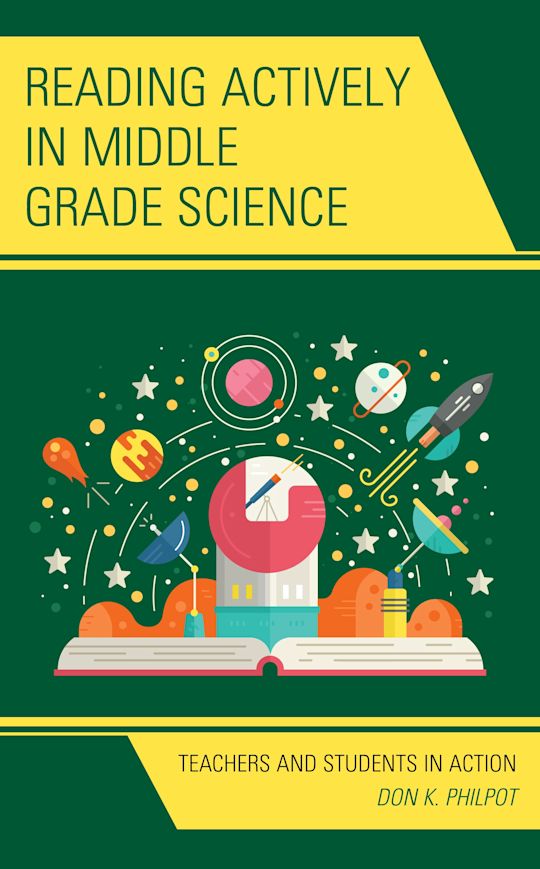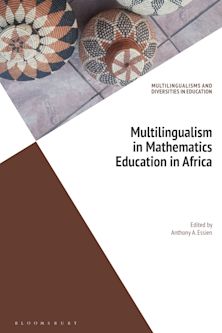- Home
- ACADEMIC
- Education
- Teaching Specific Subjects
- Reading Actively in Middle Grade Science
You must sign in to add this item to your wishlist. Please sign in or create an account
Description
Middle grade students can learn a great deal about themselves and their world by reading informative texts in science courses. These texts will focus on important topics in earth science, life science, and physical science and shape students’ understandings about scientific inquiry, science-related processes and phenomenon, engineering and design, and technological innovations. But reading is a complex act, and most students need specific reading-related support to understand assigned texts in middle grade science courses.
This book focuses on the cyclical nature of reading, the actions proficient readers engage in to understand science textbooks and other informational texts, and the instructional support that teachers can provide to enhance middle grade students’ learning of science content through reading. Three associated questions will be addressed in this book:
•What actions do proficient readers engage in to understand assigned course texts?
•What do these actions entail, and how do they relate to each other?
• What teacher-mediated practices best support middle grade students’ development as proficient readers and enhance their learning of course content through reading?
Table of Contents
Acknowledgments
Introduction: Reading this Book
Chapter 1: Reading in the Middle Grades
Introduction
Reading in Middle Grades
Reading Beyond Middle Grades
Looking Back and Ahead
Chapter 2: The Reading Cycle
Introduction
The Reading Cycle
Proficient Reading Actions
Looking Back and Ahead
Chapter 3: Before Reading Actions
Introduction: Before Reading Phase Actions
Clarifying One’s Goal And Purpose
Generating Expectations
Activating Knowledge
Developing Knowledge
Looking Back and Ahead
Grounding: Before Reading Phase Actions
Chapter 4: During Reading Actions I
Introduction: During Reading Phase Actions
Visualizing
Reading Fluently
Looking Back and Ahead
Grounding: During Reading Phase Actions
Chapter 5: During Reading Actions II
Introduction: During Reading Phase Actions
Reading for Understanding
Inferencing
Looking Back and Ahead
Grounding: During Reading Phase Actions
Chapter 6: During Reading Actions III
Introduction: During Reading Phase Actions
Formulating
Building Coherence
Looking Back and Ahead
Grounding: During Reading Phase Actions
Chapter 7:After Reading Actions
Introduction: After Reading Phase Actions
Summarizing
Reconfiguring
Assessing
Clarifying
Looking Back and Ahead
Grounding: After Reading Phase Actions
Chapter 8:Mediational Practices
Introduction
Previously Showcased Practices
Before Reading Mediational Practices
After Reading Mediational Practices
Multi-Phase Mediational Practices
Selection Guide and Further Reading
References
About the Author
Product details
| Published | 15 Sep 2020 |
|---|---|
| Format | Ebook (Epub & Mobi) |
| Edition | 1st |
| Extent | 246 |
| ISBN | 9781475843972 |
| Imprint | Rowman & Littlefield Publishers |
| Illustrations | 17 b/w illustrations;33 tables; 2 textboxes |
| Publisher | Bloomsbury Publishing |
About the contributors
Reviews
-
Spanning the disciplines of science and language arts, this resource offers middle school teachers practical approaches to helping their students succeed as young learners. Grounded in the cyclical nature of reading as a complex undertaking, the overarching aim of this book is to enhance middle school students’ learning of science through reading. The first section introduces a reading cycle that focuses on student actions, such as activating knowledge, visualizing, and summarizing, which map to the three phases of reading that anchor this book (orienting, sustaining, and consolidating). The use of examples and concept maps ensure that this approach is conveyed in a clear and applicable manner. The following section, which comprises the bulk of this volume, presents essential actions for readers in a straightforward approach that busy professionals will appreciate. The final section expands on various meditational practices for students and is a strong conclusion to a no-nonsense book designed to promote improved science learning through strategic and purposeful approaches to reading. This is a welcome resource for practicing teachers looking to collaborate with colleagues across traditional disciplinary lines, as well as for teachers in training looking to build a repertoire of successful instructional practices. Highly recommended.
Choice Reviews
-
Reading Actively in Middle Grade Science is exactly what I needed when I was a secondary science teacher! Dr. Philpot takes the reader on a detailed journey replete with examples of how middle school science teachers can engage students in reading informational text. This text helps teachers—especially middle school science teachers—understand how to engage students in cognitive processes that help make them more proficient readers.
Vanessa Dodo Seriki, associate professor of science education, and coordinator of graduate programs in mathematics and science education, Morgan State University
-
Philpot engagingly provides insight into middle school science teachers who believe science teaching is enhanced by literacy strategies, with specific examples from middle school science classrooms that connect theory to practice and content to communication. He begins this practical guide with what we know about middle school students and what we know about learning theory. When science teachers commit to providing the information in this book, young adolescents will be more engaged with content, will think more deeply, and will learn ways to learn more effectively. This is a wonderful manual that science teachers need in their professional library!
Nancy Ruppert, professor, University of North Carolina; Past-President AMLE Board of Trustees
-
Reading Actively in Middle Grade Science: Teachers and Students in Action provides science educators with thoughtful and practical insight into supporting middle school science students throughout the process of reading science texts. After giving a context-specific framework for proficient readers, Philpot lays the scaffolding that teachers can use to support proficient reading practices in science. The teaching vignettes and clear descriptions that follow help readers to consider the tools that will encourage proficient reading before, during, and after a reading event. Middle school science educators at any stage of their careers will find this text to be a valuable contribution to their teaching toolboxes.
Kelly Feille, Jeannine Rainbolt College of Education, University of Oklahoma
-
Having taught both reading and science methods to preservice teachers, Don Philpot contributes to the much needed body of literature that integrates literacy instruction and the science classroom. This is especially true in states that implement edTPA, in which teacher candidates must demonstrate content, process, and pedagogical knowledge while developing their own academic language skills and those of their students. Given that the great majority of elementary and middle school science programs are textbook-based, students need to apply literacy skills in order to do well in the science classroom. This book supports that learning and enables student to achieve content success, and illustrations add support for learning requisite skills and knowledge. References to the works of Halliday and Matthiesen and others provide a solid grounding in theory, while the material is also practical. I would definitely consider adopting this book for my science methods course.
Chyrese S. Wolf, literacy teacher educator, department of Elementary and Graduate Reading Education, Chicago State University
-
This book identifies ways that reading scientific texts can improve science learning and how specific strategies and teacher mediation practices support such subject-matter reading. Dr. Philpot draws on classroom examples to illustration how a cyclical model of reading helps students navigate and make sense of the often obscure nature of written scientific discourse. Teachers and teacher educators interested in applying specific strategies to support science reading in the middle grades will find this book a helpful contribution.
Gregory J. Kelly, distinguished professor and associate dean for research, College of Education, Pennsylvania State University



































